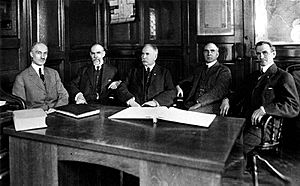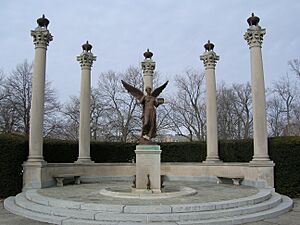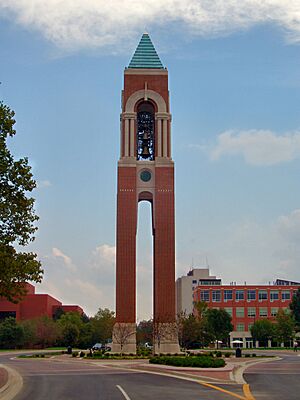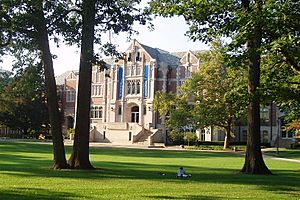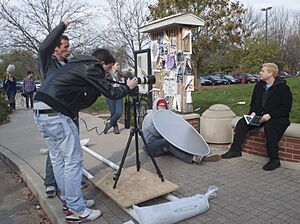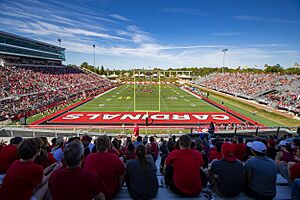Ball State University facts for kids
 |
|
|
Former name
|
Indiana State Normal School – Eastern Division (1918–1922) Ball Teachers College (1922–1929) Ball State Teachers College (1929–1961) Ball State College (1961–1965) |
|---|---|
| Motto | "We Fly" |
| Type | Public research university |
| Established | 1918 |
| Founder | Lucius L. Ball, William C. Ball, Edmund B. Ball, Frank C. Ball, George A. Ball |
| Accreditation | HLC |
|
Academic affiliations
|
Space-grant |
| Endowment | $411 million (2024) |
| President | Geoffrey Mearns |
| Provost | Anand Marri |
|
Academic staff
|
1,245 |
| Students | 20,440 (fall 2023) |
| Undergraduates | 14,874 (fall 2023) |
| Postgraduates | 5,566 (fall 2023) |
| Location |
,
,
United States
|
| Campus | Small city, 1,140 acres (4.6 km2) |
| Other campuses | |
| Newspaper | The Ball State Daily News |
| Colors | Cardinal and white |
| Nickname | Cardinals |
|
Sporting affiliations
|
|
| Mascot | Charlie Cardinal |
Ball State University (often called Ball State or BSU) is a public university in Muncie, Indiana. A public university is supported by the state government, and a research university is a place where students and professors work on new discoveries. Ball State also has smaller campuses in Indianapolis, Fort Wayne, and Fishers.
The university is made up of ten different colleges, which are like schools within the university. In 2023, about 20,400 students were enrolled. Students can choose from about 120 different subjects to major in and over 100 programs for advanced degrees.
The university was started in 1918 after the Ball brothers, who were famous for making glass jars, bought the land and gave it to the state of Indiana. The school started with just 235 students. Today, it's known for its high level of research.
Ball State's sports teams are called the Ball State Cardinals. They compete in Division I of the NCAA, which is the top level for college sports.
Contents
History
Early Schools on Campus
Before it was Ball State, the campus was home to a few other schools. The first one, the Eastern Indiana Normal School, opened in 1899 in a single building. This building is now called the Frank A. Bracken Administration Building. The school closed in 1901 because it ran out of money.
In 1902, it reopened as Palmer University after a retired banker named Francis Palmer gave the school a large sum of money. A few years later, it became the Indiana Normal College. But by 1907, it had to close again. In 1912, a group of local businessmen reopened it as the Indiana Normal Institute, but it also closed in 1917.
The Ball Brothers' Gift
In 1917, the five Ball brothers bought the closed school and its land. The Ball brothers were well-known business owners who founded the Ball Corporation. In 1918, they gave the school to the state of Indiana as a gift.
The school opened as the Indiana State Normal School – Eastern Division with 235 students. Because the Ball family was so generous, people started calling the school "Ball State." In 1922, the name was officially changed to Ball Teachers College. The Ball family continued to help the school grow by funding new buildings.
In 1929, the school was renamed Ball State Teachers College. By this time, it had over 1,000 students.
To thank the Ball family, a famous sculptor named Daniel Chester French was hired to create a special statue. His creation, called Beneficence, was unveiled in 1937. It shows an angel with her arms open, symbolizing the family's gifts to the community.
During World War II, many students and staff helped with the war effort. The university started a pilot training program and partnered with the U.S. military to train soldiers on campus.
Becoming a University
In 1961, the school became independent from Indiana State University and was renamed Ball State College. It continued to grow, adding a College of Architecture and Planning in 1965 and a College of Communication, Information, and Media in 1966.
With more students and more academic programs, the school was officially renamed Ball State University in 1965. Many of the large buildings on campus today, including residence halls and academic buildings, were built during this time of growth.
Starting in the 2000s, the university began another building boom. It also started focusing on "immersive learning," where students get to work on real-world projects. The university also became a leader in protecting the environment by building a huge geothermal energy system to heat and cool the campus.
Campus
Ball State's main campus is in Muncie, Indiana. It covers 731 acres and has over 100 buildings. The campus is known for its beautiful green spaces and thousands of trees.
The campus is divided into a few main areas called quadrangles, or "quads."
- The Old Quad is the historic heart of the campus. It has beautiful old trees and buildings with a classic style called Collegiate Gothic. This is where you can find the Beneficence statue and the David Owsley Museum of Art.
- The Central Campus has a mix of academic buildings, residence halls, and performance venues like Bracken Library and Emens Auditorium. It's also home to the 150-foot-tall Shafer Tower, a bell tower with 48 bells.
- The East Quad is the newest quad and is located near a shopping area called The Village.
- The North Residential Neighborhood was finished in 2022 and has new residence halls and a dining hall for students.
Getting Around Campus
Ball State offers a free shuttle bus service for students, with different colored routes that run every few minutes. There is also a late-night service called Charlie's Charter that can pick students up and take them anywhere on campus. The city's bus system, MITS, is also free for students.
Architecture
The buildings at Ball State show a mix of different architectural styles from over the years. Most buildings are made of red or brown brick.
The oldest building is the Frank A. Bracken Administration Building, which was built in 1899. Many of the older buildings, like the Fine Arts Building and Ball Gymnasium, were designed in the Collegiate Gothic style, which looks like old European universities.
In the 1960s and 1970s, many buildings were built in a style called Brutalism, which features large, solid brick walls. The Teachers College Building is the tallest on campus at 10 floors. Newer buildings on campus have a more modern look, with large windows and open spaces.
Sustainability
Ball State is committed to being environmentally friendly. Many of its new and renovated buildings are designed to be energy-efficient and have earned LEED certification. The university also recycles and uses hybrid vehicles.
Geothermal System
One of the university's biggest green projects is its geothermal energy system, one of the largest in the country. Instead of burning coal, the university uses the natural heat from the ground to warm and cool its buildings. This system uses thousands of underground pipes and has greatly reduced the university's impact on the environment.
Other Locations
Ball State has two smaller locations in other Indiana cities.
- CAP: INDY in Indianapolis is a center for students studying architecture and urban design.
- The Fishers Center for Academic and Economic Innovation in Fishers offers programs for students and local businesses.
Academics
Ball State offers a wide variety of degrees for students. The average class size is about 21 students, which means students can get personal attention from their professors.
Student Body
About 21,500 students attend Ball State. Most students are from Indiana, but about a quarter come from other states and countries. The university welcomes students from all backgrounds.
Colleges
Ball State is organized into several colleges, each focusing on different areas of study:
- Teachers College
- College of Sciences and Humanities
- College of Fine Arts
- Estopinal College of Architecture and Planning
- College of Communication, Information, and Media
- Miller College of Business
- College of Health
Library System
Bracken Library is the main library on campus. It has five floors filled with books, computers, and study areas. The library system gives students access to millions of resources, including books, maps, and music. It also has special collections, like the Center for Middletown Studies, which researches life in Muncie.
Student Life
Housing
Ball State has 14 residence halls, which are dorms where students live. Many of these halls are "living-learning communities," where students in the same major live together and participate in special activities. This helps students make friends and succeed in their classes.
Student Activities
There are more than 400 student organizations at Ball State. These include groups for different majors, hobbies, and service projects. There are also many multicultural organizations, such as the Black Student Association and the Latinx Student Union. Ball State also has about 30 fraternities and sororities.
Media
Students run several media organizations on campus, giving them hands-on experience in journalism, broadcasting, and more.
- The Ball State Daily News is the student newspaper.
- WCRD is the student-run radio station.
- NewsLink Indiana is a TV news broadcast that covers local and national news.
- Ball State Sports Link provides live coverage of Cardinals athletic events.
Athletics
Ball State's sports teams are called the Cardinals. They compete in the NCAA Division I and are part of the Mid-American Conference (MAC). The school's mascot is Charlie Cardinal, named after Indiana's state bird.
The football team has been playing since 1924. They have won six conference championships and played in several bowl games. In 2020, they won the Arizona Bowl, which was their first-ever bowl game victory.
The men's basketball team has also had great success. Between 1981 and 2000, the team won the MAC tournament seven times. In 1990, they made it to the "Sweet Sixteen" round of the NCAA tournament.
Traditions
Beneficence
The Beneficence statue, nicknamed "Benny," is a beloved symbol of the university. It was created by Daniel Chester French, the same artist who sculpted the statue of Abraham Lincoln in the Lincoln Memorial. The statue honors the five Ball brothers for their generosity.
Frog Baby
The Frog Baby statue is another popular landmark. For years, students would rub its nose for good luck before exams. The statue is now in a fountain, and students have a new tradition of dressing it up in hats and scarves for the winter or jerseys for big games.
Homecoming
Homecoming is a major event each fall that started in 1926. It includes a big parade through campus and The Village. One of the most popular traditions is the Bed Race, where teams of students race beds on wheels down a street.
Notable Alumni
Ball State has produced many successful graduates who have become leaders in business, arts, and more.
- Jim Davis, the creator of the Garfield comic strip.
- David Letterman, a famous talk show host.
- Angela Ahrendts, a former top executive at Burberry and Apple.
- Doug Jones, an actor known for playing non-human characters in movies.
- John Schnatter, the founder of Papa John's Pizza.
Images for kids
See also
 In Spanish: Universidad Estatal Ball para niños
In Spanish: Universidad Estatal Ball para niños


